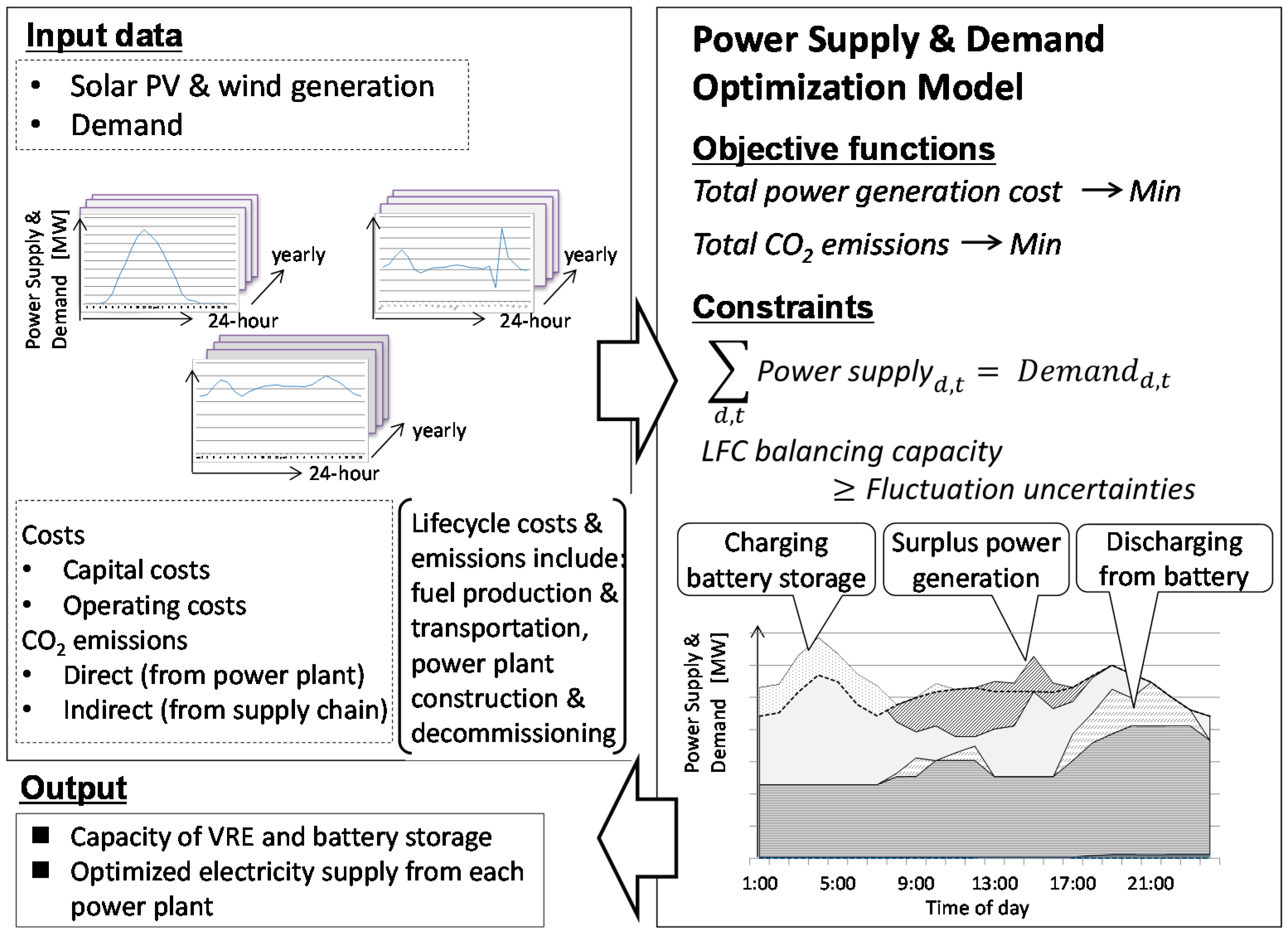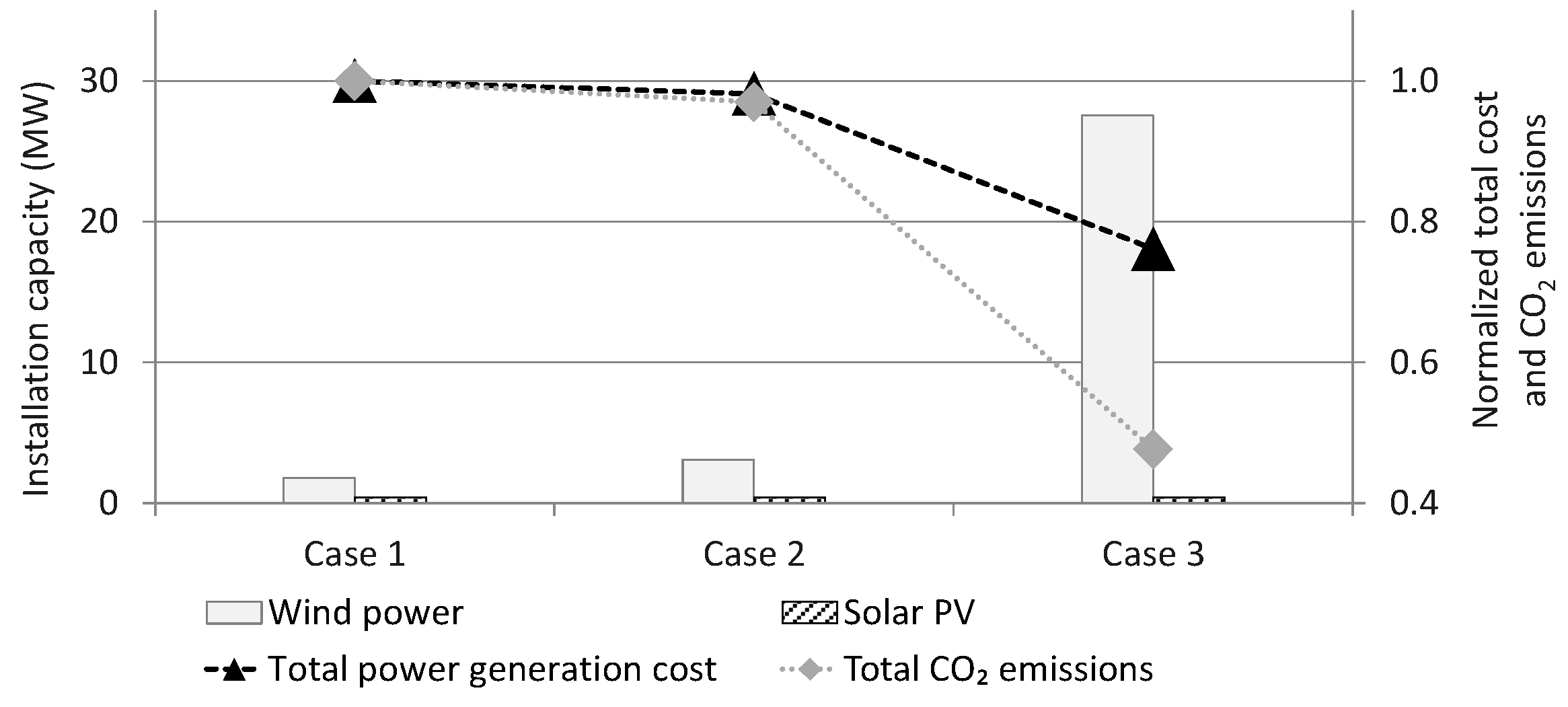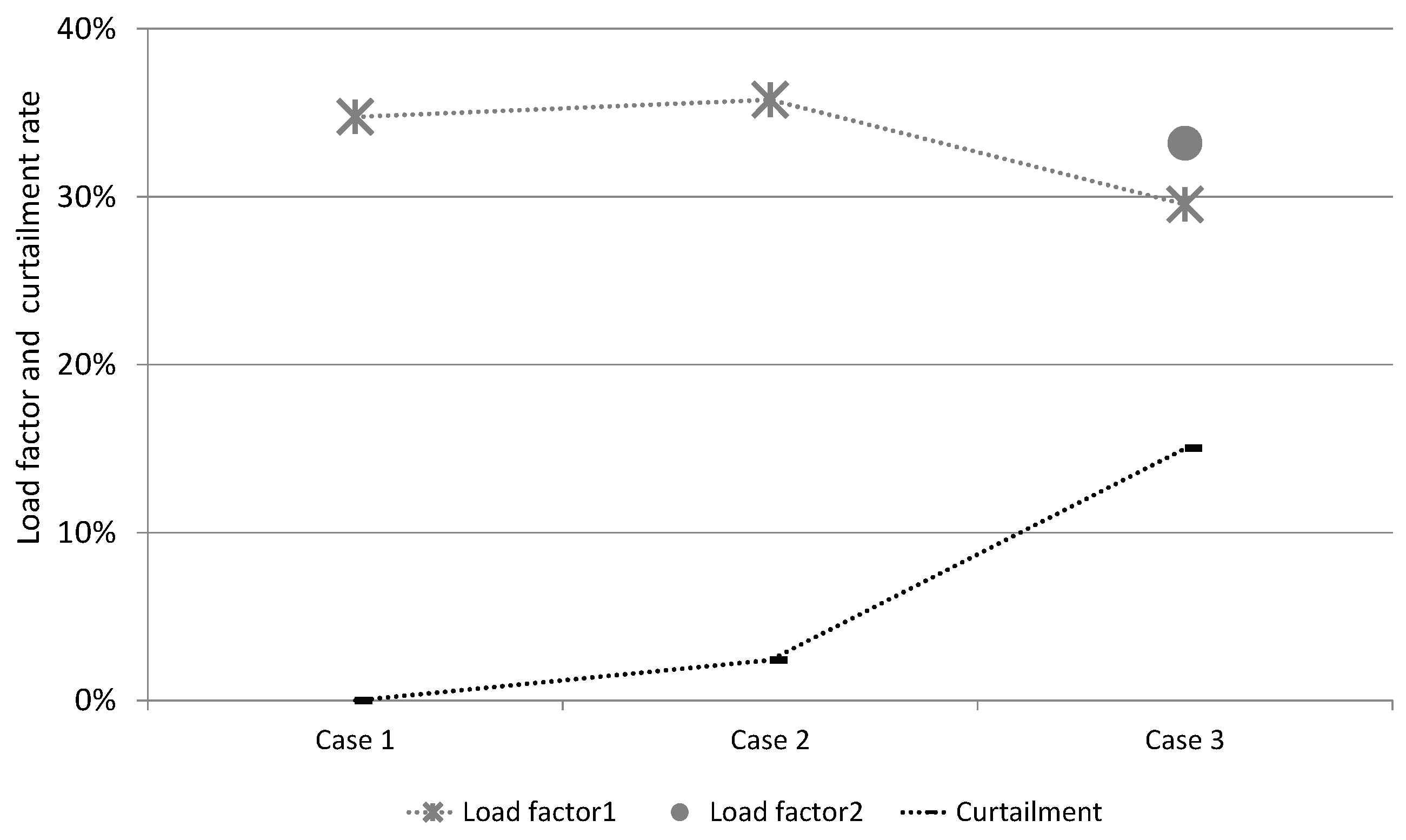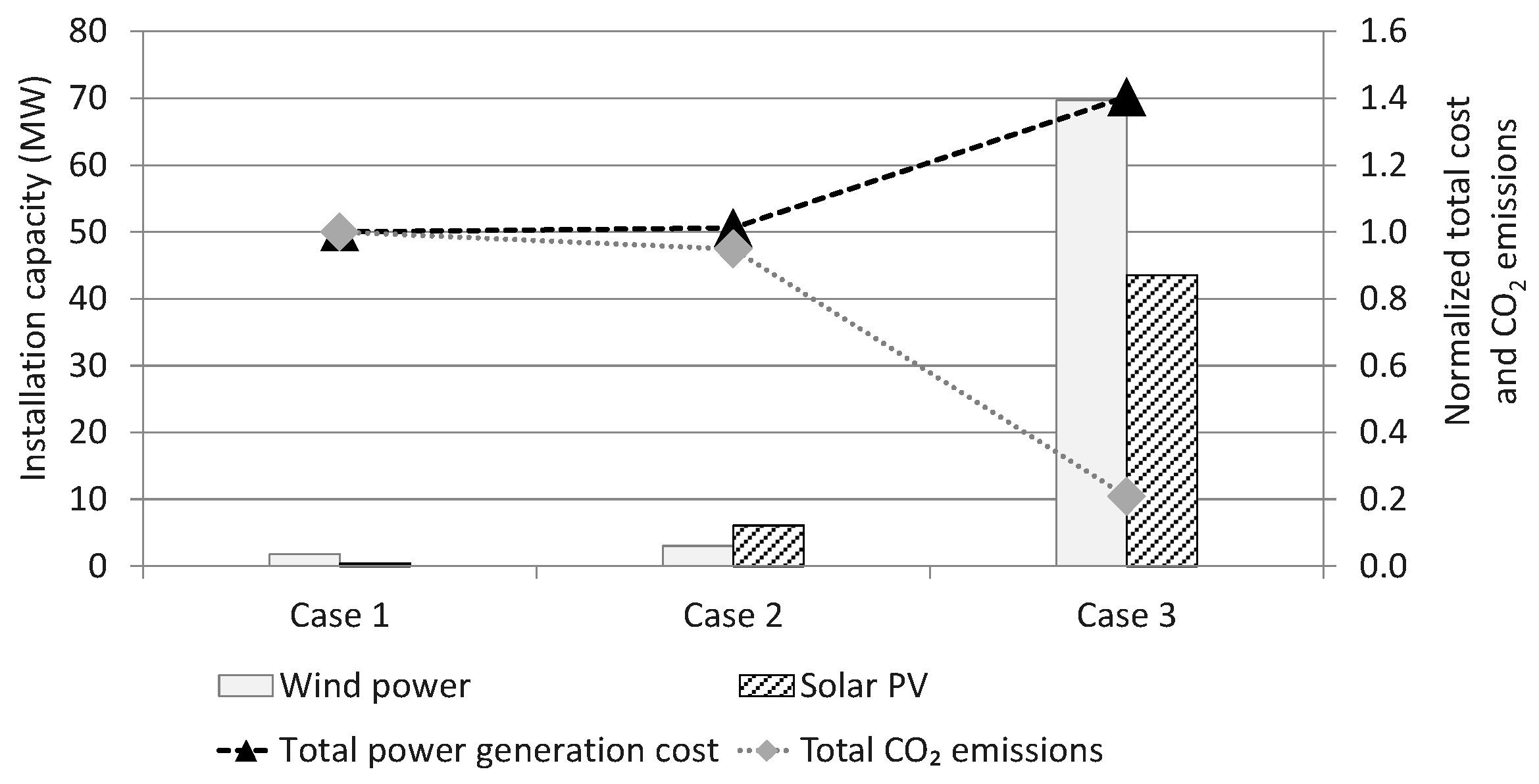Evaluating the Potential of Variable Renewable Energy for a Balanced Isolated Grid: A Japanese Case Study
Abstract
:1. Introduction
2. Materials and Methods
2.1. Overview of the Model
2.2. Model Configuration
- Balancing power supply and demand:
- Constraints on battery storage
- VRE constraints
- LFC constraints
2.3. Case Study Site and Its Electricity Supply and Demand Data
2.4. VRE Power Generation Estimates
2.4.1. Wind Power
2.4.2. Solar PV
2.5. Model Parameters
2.6. Simulation Cases Settings
3. Results and Discussion
3.1. Total Power Generation Cost Minimization
3.2. Example Generation Mix
3.3. Load Factor
3.4. Sensitivity to Minimum Thermal Plant Generation
3.5. Minimizing Total CO2 Emissions
4. Conclusions
Author Contributions
Conflicts of Interest
Appendix A
| Irradiance | Variables Used | Calculation Notes |
|---|---|---|
| Direct normal irradiance on inclined surface | 1. Direct normal irradiance | Calculated from global horizontal irradiance and the diffuse horizontal irradiance. |
| 2. Angle of incidence angle for direct irradiance to solar PV cell surface | Calculated using the solar PV cell’s inclination and azimuth angles. | |
| 3. Solar altitude | Calculated using the declination and hour angle of the sun, which are determined astronomically, and the latitude of the site. | |
| Reflected solar irradiance on inclined surface | 4. Global horizontal irradiance | Calculated using the extraterrestrial irradiance—which is determined from the solar constant, solar altitude and geocentric solar distance—and the ratio of sunshine hours and hours of daylight. |
| 5. Inclination angle of solar PV cell | ||
| Diffuse solar irradiance on inclined surface | 6. Diffuse solar irradiance | Calculated using the ratio of global horizontal irradiance and extraterrestrial irradiance. |
| 7. Inclination angles of solar PV cell |
References
- Lund, H. Renewable energy strategies for sustainable development. Energy 2007, 32, 912–919. [Google Scholar] [CrossRef]
- Evans, A.; Strezov, V.; Evans, T.J. Assessment of sustainability indicators for renewable energy technologies. Renew. Sustain. Energy Rev. 2009, 13, 1082–1088. [Google Scholar] [CrossRef]
- Jaramillo-Nieves, L.; del Río, P. Contribution of Renewable Energy Sources to the Sustainable Development of Islands: An Overview of the Literature and a Research Agenda. Sustainability 2010, 2, 783–811. [Google Scholar] [CrossRef]
- Dincer, I. Renewable energy and sustainable development: A crucial review. Renew. Sustain. Energy Rev. 2000, 4, 157–175. [Google Scholar] [CrossRef]
- International Energy Agency (IEA). Medium-Term Renewable Energy Market Report 2015; OECD/IEA: Paris, France, 2015. [Google Scholar]
- United Nations Framework Convention on Climate Change (UNFCCC). Report of the Conference of the Parties on Its Twenty-First Session; UNFCCC: Berlin, Germany, 2015. [Google Scholar]
- Cochran, J.; Bird, L.; Heeter, J.; Arent, D.J. Integrating Variable Renewable Energy in Electric Power Markets: Best Practices from International Experience, Summary for Policymakers; NREL (National Renewable Energy Laboratory, U.S. Department of Energy): Golden, CO, USA, 2012.
- Agency for Natural Resources and Energy; Japan Ministry of Economy, Trade and Industry (METI). Feed-In Tariff Scheme in Japan; METI: Tokyo, Japan, 2012.
- Nikkei, B.P. Kyushu Electric Announces Output Restriction Records. Available online: http://techon.nikkeibp.co.jp/atclen/news_en/15mk/051000562/?ST=msbe (accessed on 20 July 2016).
- Baños, R.; Manzano-Agugliaro, F.; Montoya, F.G.; Gil, C.; Alcayde, A.; Gómez, J. Optimization methods applied to renewable and sustainable energy: A review. Renew. Sustain. Energy Rev. 2011, 15, 1753–1766. [Google Scholar] [CrossRef]
- Connolly, D.; Lund, H.; Mathiesen, B.V.; Leahy, M. A review of computer tools for analysing the integration of renewable energy into various energy systems. Appl. Energy 2010, 87, 1059–1082. [Google Scholar] [CrossRef]
- Luderer, G.; Krey, V.; Calvin, K.; Merrick, J.; Mima, S.; Pietzcker, R.; van Vliet, J.; Wada, K. The role of renewable energy in climate stabilization: Results from the EMF27 scenarios. Clim. Chang. 2014, 123, 427–441. [Google Scholar] [CrossRef] [Green Version]
- Shiraki, H.; Ashina, S.; Kameyama, Y.; Hashimoto, S.; Fujita, T. Analysis of Optimal Locations for Power Stations and Their Impact on Industrial Symbiosis Planning under Transition toward Low-carbon Power Sector in Japan. J. Clean. Prod. 2016, 114, 81–94. [Google Scholar] [CrossRef]
- Komiyama, R.; Fujii, Y. Assessment of massive integration of photovoltaic system considering rechargeable battery in Japan with high time-resolution optimal power generation mix model. Energy Policy 2014, 66, 73–89. [Google Scholar] [CrossRef]
- Komiyama, R.; Otsuki, T.; Fujii, Y. Energy modeling and analysis for optimal grid integration of large-scale variable renewables using hydrogen storage in Japan. Energy 2015, 81, 537–555. [Google Scholar] [CrossRef]
- Ogimoto, K.; Kataoka, K.; Ikegami, T.; Nonaka, S.; Azuma, H.; Fukutome, S. Demand–Supply Balancing Capability Analysis for a Future Power System. Electr. Eng. Jpn. 2014, 186, 21–30. [Google Scholar] [CrossRef]
- Yoo, K.; Park, E.; Kim, H.; Ohm, J.Y.; Yang, T.; Kim, K.J.; Chang, H.J.; del Pobil, A.P. Optimized Renewable and Sustainable Electricity Generation Systems for Ulleungdo Island in South Korea. Sustainability 2014, 6, 7883–7893. [Google Scholar] [CrossRef]
- Senjyu, T.; Hayashi, D.; Yona, A.; Urasaki, N.; Funabashi, T. Optimal configuration of power generating systems in isolated island with renewable energy. Renew. Energy 2007, 32, 1917–1933. [Google Scholar] [CrossRef]
- Duić, N.; Carvalho, M.D.G. Increasing renewable energy sources in island energy supply: Case study Porto Santo. Renew. Sustain. Energy Rev. 2004, 8, 383–399. [Google Scholar] [CrossRef]
- Pandey, S.K.; Mohanty, S.R.; Kishor, N. A literature survey on load–frequency control for conventional and distribution generation power systems. Renew. Sustain. Energy Rev. 2013, 25, 318–334. [Google Scholar] [CrossRef]
- Kuramoto, M.; Nagata, M.; Inoue, T. A Modified Algebraic Method to Evaluate Required Capacity for Frequency Control under a Large Penetration of Solar PV Generations; Research Report 2011, R10005; CRIEPI (Central Research Institute of Electric Power Industry): Tokyo, Japan, 2011. (In Japanese) [Google Scholar]
- Yamamoto, H.; Bando, S.; Sugiyama, M. Development of a Power Generation Mix Model Considering Multi Modes of Operation of Thermal Power Fleets and Supply-Demand Adjustability; Research Report 2014, Y12030; CRIEPI (Central Research Institute of Electric Power Industry): Tokyo, Japan, 2014. (In Japanese) [Google Scholar]
- New Energy and Industrial Technology Development Organization (NEDO). Guidebook on Wind Power Introduction; NEDO: Tokyo, Japan, 2008. (In Japanese)
- Japan Meteorological Agency, Japan (JMA). Automated Meteorological Data Acquisition System (AMeDAS). Available online: http://www.data.jma.go.jp/obd/stats/etrn/index.php (accessed on 20 July 2016). (In Japanese)
- New Energy and Industrial Technology Development Organization (NEDO). Reference of NEDO Standard Meteorological database. Japan Weather Association. Available online: http://www.nedo.go.jp/content/100778067.pdf (accessed on 20 July 2016). (In Japanese)
- Erbs, D.G.; Klein, S.A.; Duffie, J.A. Estimation of the Diffuse Radiation Fraction for Hourly, Daily and Monthly Average Global Radiation. Sol. Energy 1982, 28, 293–302. [Google Scholar] [CrossRef]
- Masaki, Y.; Kuwagata, T.; Ishigooka, Y. Precise estimation of hourly global solar radiation for micrometeorological analysis by using data classification and hourly sunshine. Theor. Appl. Climatol. 2010, 100, 283–297. [Google Scholar] [CrossRef]
- Cost Verification Committee. Report of the Cost Verification Committee 2011; Cabinet Office, Government of Japan: Tokyo, Japan, 2011. (In Japanese)
- Agency for Natural Resources and Energy; Ministry of Economy, Trade and Industry (METI). Price Survey of Petroleum Products 2011; METI: Tokyo, Japan, 2011. (In Japanese)
- Imamura, E.; Nagano, K. Evaluation of Life Cycle CO2 Emissions of Power Generation Technologies—Update for State-of-the-Art Plants; Research Report 2010, Y09027; CRIEPI (Central Research Institute of Electric Power Industry): Tokyo, Japan, 2010. (In Japanese) [Google Scholar]
- Japan Automobile Research Institute (JARI); Special Committee of Synthesis Study on Efficiency. The Results about Efficiency from Synthesis Study; JHFC Japan Hydrogen & Fuel Cell Demonstration Project; Japan Automobile Research Institute (JARI): Tsukuba, Japan, 2006. (In Japanese) [Google Scholar]
- World Bank. Official Exchange Rate (LCU per USS, Period Average). Available online: http://data.worldbank.org/indicator/PA.NUS.FCRF?locations=JP (accessed on 12 August 2016).
- Ministry of Economy, Trading and Industry (METI). Strategy of Battery 2012; Project Team for Strategy of Battery; METI: Tokyo, Japan, 2012. (In Japanese)
- Sullivan, J.; Gaines, L. A Review of Battery Life-Cycle Analysis: State of Knowledge and Critical Needs; Argonne National Laboratory Report 2010, ANL/ESD/10-7; Argonne National Laboratory: Argonne, IL, USA, 2010.
- Komiyama, R.; Shibata, S.; Nakamura, Y.; Fujii, Y. Analysis of Possible Introduction of PV Systems Considering Output Power Fluctuations and Battery Technology, Employing an Optimal Power Generation Mix Model. Electr. Eng. Jpn. 2013, 182, 9–19. [Google Scholar] [CrossRef]








| Diesel Thermal Plant | Hydro Power Plant | Wind Power Plant | Residential Solar PV System | |
|---|---|---|---|---|
| Reference for cost estimate [28] | 400 MW oil-fired | 0.2 MW | 20 MW onshore | 4 kW residential |
| Capital cost [Yen/kW] [28] | 5054 | 26,633 | 14,896 | 23,100 |
| Operation cost [Yen/kW] [28] | 6681 | 74,100 | 13,566 | 8250 |
| Fuel cost [Yen/kWh] | 23.05 | - | - | - |
| Reference for emissions estimate [30] | 1000 MW heavy oil | 10 MW | 0.6 MW onshore | 4 kW residential |
| Indirect emissions [t-CO2/kW] [30] | 0.32 | 0.04 | 0.04 | 0.05 |
| Direct emissions [t-CO2/kWh] [30] | 0.0007 | n/a | n/a | n/a |
| Model Parameter | Value |
|---|---|
| Manufacturing cost [Yen/kWh] [33] | 2667 |
| Emissions from manufacturing stage [t-CO2/kWh] [34] | 0.008 |
| Parameter | Value |
|---|---|
| 0.3 [MW] | |
| , | 95% |
| 20% | |
| 6 [kWh/kW] [35] | |
| 5% | |
| 100% | |
| 4% | |
| 1% | |
| 50% | |
| 50% |
© 2017 by the authors; licensee MDPI, Basel, Switzerland. This article is an open access article distributed under the terms and conditions of the Creative Commons Attribution (CC-BY) license (http://creativecommons.org/licenses/by/4.0/).
Share and Cite
Inoue, M.; Genchi, Y.; Kudoh, Y. Evaluating the Potential of Variable Renewable Energy for a Balanced Isolated Grid: A Japanese Case Study. Sustainability 2017, 9, 119. https://doi.org/10.3390/su9010119
Inoue M, Genchi Y, Kudoh Y. Evaluating the Potential of Variable Renewable Energy for a Balanced Isolated Grid: A Japanese Case Study. Sustainability. 2017; 9(1):119. https://doi.org/10.3390/su9010119
Chicago/Turabian StyleInoue, Mai, Yutaka Genchi, and Yuki Kudoh. 2017. "Evaluating the Potential of Variable Renewable Energy for a Balanced Isolated Grid: A Japanese Case Study" Sustainability 9, no. 1: 119. https://doi.org/10.3390/su9010119






